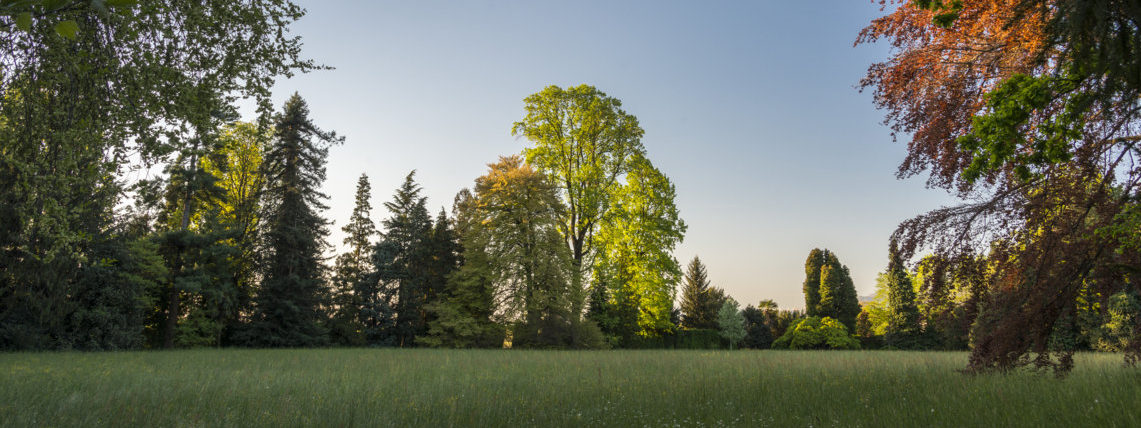The name Lagerstroemia comes from the Swede Magnus von Lagerstroem, a director of the Swedish Indies Company in the 18th century, who sent the first seedlings to Europe to Linnaeus for classification. The Lagerstroemia (or crape myrtle) genus includes about 50 species of small and large-scale trees, originating in Asia and Northern Australia. These are flowering trees and are often planted in ornamental gardens for their beautiful flowers which can be seen from July to September. Lagerstroemia is also referred to as a “naked tree”, because of the appearance of its trunk and branches which covered by a smooth yellow-beige bark.
Origin: temperate China
Next to the tulip tree stands a beautiful Fagus sylvatica asplenifolia (fern leaf beech). It is one of the trees that tends to sleep a little longer in Spring than the others and awakes later from winter, showing small leaves and buds later than the other trees around it. This is why its foliage is always a tad brighter than the others and stays so throughout the summer.
Origin: Europe
It is an evergreen conifer, which has found a comfortable habitat here in the Park that has allowed it to thrive and grow to over 30 meteres. The Sequoia was the tallest tree in the park until a few years ago when lightning struck its tip in a violent thunderstorm. Fortunately, this beautiful green giant continued to grow in health, showing the signs of a complete recovery, which suggests that one day perhaps rit will once agin be the highest tree.
Take a moment to stroke its soft bark and note the new trees growing spontaneously at its side.
Origin: North America
The Bamboo wood is one of the most magical corners of the garden. The peculiarity of bamboo and the important presence of water make it an ideal place to enjoy moments of real tranquility. Just what led bamboo being in the Park is not known. It might have been the typical habit of collecting plants for prestigious 19th-century parks, or it might have been the illuminated vision of a more recent gardener-maintainence man. Whatever the reason, thanks to its elegant appearance and its strong ornamental nature, it was introduced and grown to form a wood.
Origin: Asia
Hydrangea is one of the representative flowers of the Park. Countess Sofia loved this wonderful shrub and filled her garden with herself with it. She introduced so many bushes that, nearly century on, many still bloom today in several areas of the garden. Since 2008, the Cosso Foundation, in its careful and respectful restoration work, has carried out a census of the species present in the Park, thanks to which it has been possible to elaborate a plan to restore the original design and proceed with the planting of new specimens.
From mid-June to September, the Park is transformed into the realm of hydrangeas: luxuriant bushes, unusual shapes and intense, or pale colours can be found here and there, while strolling along the paths. Most species generally prefer of a cool microclimate, damp soil and light shade, others grow and thrive in sunny areas provided they have sufficient water.
In 2019 the project “Invitation to the Park. The Camellia Garden” prompted an extensive planting endeavour during which more than 130 ancient camellia cultivars were planted, adding to the fully-grown plants historically present in the Castle’s Park. Extracted from a neglected environment, these cultivars were transplanted in the protected environment of Miradolo in 2020 and 2021, and were subjected to extensive observation and mapping activities that will continue over time. From 2022 onwards, their value will be increasingly enhanced thanks to the drafting of maps and botanical files of all the specimens, the organisation of themed meetings, educational events and tea tastings, multiple opportunities to promote the in-depth study and enhance the appreciation of botany and landscape studies. Each spring will bring the chance to further enhance this splendid flower and enjoy a collection which, over the years, will brighten up the Park with splendid patches of colour.
By receiving Camellia japonica cultivars from two of the oldest and most valuable collections in Italy, the Cosso Foundation has ensured the survival of a significant natural and cultural heritage, especially since it has been estimated that about half of the cultivars introduced are the only surviving specimens in Italy, in addition to those present in the original camellia groves located in the gardens of the former Hotel Eden in Verbania Pallanza, where the historic Rovelli nurseries stood until the beginning of the 20th century, and in the park of Villa Durazzo Pallavicini in Genoa Pegli.
With the support of: Fondazione Compagnia di San Paolo
In partnership with: Società Italiana della Camelia and DISAFA – Università degli Studi di Torino

